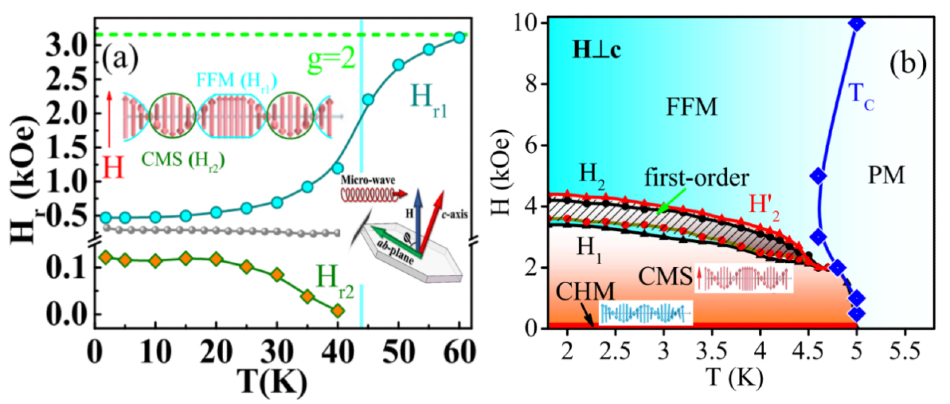Aug 3 2020
A new study performed by Prof. ZHANG Lei and his colleagues at the High Magnetic Field Laboratory, Hefei Institutes of Physical Science has unraveled the anisotropic microwave response and interactions of Chiral Magnetic Soliton (CMS).
 (a) Microwave response of MnNb3S6; (b) H-T phase diagram of YbNi3Al9. Image Credit: Courtesy of the researchers.
(a) Microwave response of MnNb3S6; (b) H-T phase diagram of YbNi3Al9. Image Credit: Courtesy of the researchers.
In a CMS, which is a “quasi-particle” magnetic configuration, spins are arranged in a spiral way. It acts similarly to a topological magnetic kink structure. In general, CMS phases tend to occur in monoaxial helimagnetic systems, where Dzyaloshinskii–Moriya (DM) interaction occurs because of the absence of inversion symmetry in structure.
The conflict between ferromagnetic exchange and DM interaction typically leads to a chiral helimagnetic ordering ground state. The chiral helimagnetic ordering phase can be modified into spiral spin-textures by applying an external magnetic field appropriately along a specific crystal direction. The spiral spin-textures show properties of topological quasi-particles at the nanoscale.
Among all such topological quasi-particles, the CMS is the most prominent. Most significantly, it is possible to modulate the CMS by using pressure, magnetic, electric current injection, microwave, and other means, paving the way for prospective applications in spintronics.
CMS is created as a result of complicated coupling and conflict between orbit charge, spin, and crystal lattice degrees of freedom. Due to the stringent conditions, CMS phases can be found only in specific materials such as ion-doped YbNi3Al9 and ion-intercalated MNb3S6 systems. Fascinatingly, CMS has been found to exhibit a peculiar response to microwave.
Drawing inspirations from this point, the researchers explored the microwave response of MnNb3S6 by using electron spin resonance and, therefore, unraveled the anisotropic microwave response of the CMS.
Moreover, the researchers expanded their study further to investigate the critical behavior of YbNi3Al9, which is another CMS material, where anisotropic spin interactions were revealed and a comprehensive H–T phase diagram was developed explicitly.
The studies could offer further insights into the mechanisms behind CMS.
This study was financially supported by the National Key R&D Program of China, the open research program from the Science and Technology Commission of Shanghai Municipality, the Users with Excellence Program of Hefei Science Center of the Chinese Academy of Sciences, and the National Natural Science Foundation of China.
A part of this study was financially supported by the High Magnetic Field Laboratory of Anhui Province.
Journal Reference:
Dai, Y., et al. (2020) Microwave response of the chiral helimagnetic MnNb3S6. Applied Physics Letters. doi.org/10.1063/5.0007901.